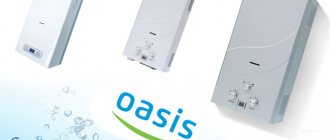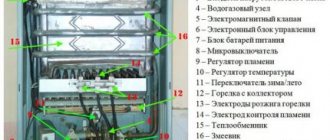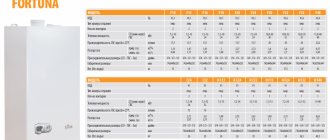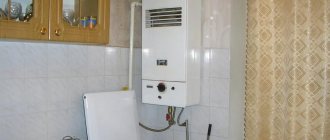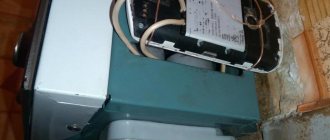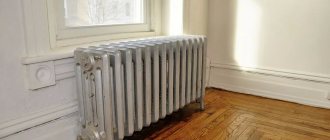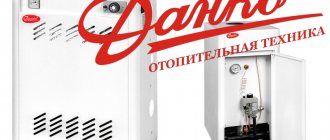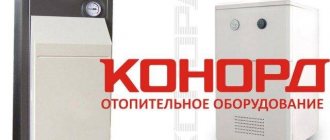Here you will learn:
- Geyser Oasis Glass 20VG
- Geyser Oasis, 24 kW, white
- Geyser Oasis Glass 20ZG
- Geyser Oasis B-12W
- Geyser Oasis TUR 20
- Geyser Oasis 26 kW, white
Oasis geysers have gained their popularity due to their simplicity of design and extremely affordable price - the simplest model can be purchased for 6-7 thousand rubles. They are installed in individual apartments and private households, preparing hot water under powerful burners. The combustion chambers in Oasis geysers are open, which is another reason for the low cost of the equipment.
In an effort to provide its customers with simple but modern water heating technology, the manufacturer has done a good job on the design of the speakers. In this regard, speakers from the Oasis Glass range appeared on the market. Their fundamental difference is the finishing of the front panels with glass with certain patterns. Thanks to this, Oasis geysers fit perfectly into the interiors of bathrooms and kitchens. For more convenient control, all models are equipped with small liquid crystal displays that display the heating temperature. There are three controls in total:
- Flow regulator;
- Gas supply regulator;
- Winter-summer switch.
Simplicity and accessibility have become the main trump cards of Oasis gas instantaneous water heaters. Let's see what users say about them.
In addition to the reviews themselves, we will publish the advantages and disadvantages identified by users during operation.
Geyser Oasis Glass 20VG
Renat
We decorated the kitchen in the apartment in dark colors and decided to find a column that would match the main color tone. The only acceptable offer in our city was the Oasis Glass 20VG gas water heater, black, with a glass panel and with a beautiful picture. The seller immediately warned that this was the simplest speaker, but we weren’t looking for any bells and whistles. The problems began six months after the purchase - this semi-Chinese monster began to go out, and it was impossible to set the desired temperature. After another month, we threw this speaker into the trash and bought a normal Italian speaker. I won’t recommend Oasis - don’t get burned by Chinese cheap stuff.
Advantages:
- Solid appearance - the speaker fits perfectly into our dark kitchen. Also, there were other colors on sale;
- Affordable price - Oasis geysers are affordable for everyone.
Flaws:
- It goes out for no apparent reason - you can’t count on a comfortable shower;
- It is impossible to regulate the temperature - it jumps all the time, up and down.
A few words about the manufacturer
The manufacturer of Oasis water heaters, Forte Home GmbH, is an association of investors headquartered in Germany. Its products include brands such as Halsen, Zerten, Alecord. The range of products, in addition to water heaters, includes:
- radiators;
- pumps;
- boilers.
The Oasis storage water heater operates on a closed principle.
Forte Home GmbH occupies a leading position in the market for devices that provide a comfortable climate in the home, not only due to the high quality of its products, but also due to its consumer-oriented policy.
There are authorized sales and repair centers in every region of Russia. For example, in Tyumen you can order Oasis water heaters in the online store of the Kvanta+ company.
Geyser Oasis, 24 kW, white
Elena
The main criterion when choosing a speaker was the price. We didn’t want to buy complete nonsense, so we decided to go with an Oasis gas water heater. We chose a 24 kW model with a flow rate of up to 12 l/min. This is quite enough for a kitchen faucet and a shower stall, even if you turn them on at the same time. The speaker pleased with its compactness and pleasant appearance. The number of regulators is minimal - set the desired temperature and forget. In winter you have to increase the temperature, since there is no automatic temperature monitoring. The ignition runs on two batteries; no connection to the electrical network is required, which is a big plus for our area.
Advantages:
- The speaker is very compact, not very thick, and the design is extremely neat;
- For ease of setup, a solid “five”, since there is nothing superfluous here - only basic functionality.
Flaws:
- The main disadvantage is the high noise level. If you increase the gas pressure, it makes a lot of noise, and this noise can be heard in the rooms;
- The batteries run out quickly - we don’t use it that actively, but we have to change the batteries every month. I know for sure that they should last a long time, but for some reason this is not the case.
Review of Oasis water heater models
All electric models offered under the Oasis brand can be divided into 5 lines:
- Standard;
- Plain;
- Steel;
- Small;
- Slim.
The first of them distinguishes the following models:
- "Oasis VG", supplied with tanks with a capacity of 30, 50 and 80 l;
- "Oasis VC", which is equipped with a tank with a capacity of up to 100 liters.
The Plain series also has 2 modifications. Its difference from the Standard line comes down to the installation of a double internal tank. Simultaneous distribution of water to several points is supported.
Steel modifications are made of non-magnetic stainless steel and include additional elements for installation. Representatives of the Small series differ only in tank capacity - 10 and 15 liters.
Slim water heaters differ not only in the shape of the water storage tank, but also in such properties as glass enamel coating of the tank and the presence of a safety valve.
Slim series water heaters are easy to use, reliable and durable.
Gas water heaters are presented in the following series:
- Standard;
- Glass;
- Turbo;
- Modern.
All models have a “Winter-Summer” switch, which makes it possible to save gas. Suitable for operation at reduced pressure. Automatically turn on and off when opening/closing the tap. Product lines vary in characteristics such as:
- presence of forced ejection;
- power supply of the auto-ignition system from the mains or batteries;
- Possibility to operate from gas cylinders.
Geyser Oasis Glass 20ZG
Natalya
I fell in love with this column at first sight, not yet knowing how much disappointment it would bring. This unit has become a real curse, as it lives its own life. The Oasis gas water heater lights up and goes out at the most inopportune moment. And the worst thing is that not a single master has yet been able to say what is wrong with her. Visually everything is fine, the burner is not clogged, the chimney works perfectly, it has been checked more than once. But the pump continues to go out, tormenting everyone in the household. And recently water started dripping from it. And every day it dripped more and more. It turned out that literally within a year the heat exchanger had become almost completely unusable. I understand perfectly well that this is an initially cheap speaker, but it should have lasted at least several years?
Advantages:
- Good appearance, with pattern on the front;
- Low price is an excellent advantage over competitors with similar characteristics.
Flaws:
- The “independent” life of this speaker is simply infuriating; preventive inspections and replacement of some components did not help get rid of problems with the unit;
- Short service life of the heat exchanger, it feels like it was already rotten and rusty from the very beginning;
- Sometimes it lights up with a bang that scares a small child.
Frequent malfunctions and their elimination
Before you start troubleshooting the Oasis brand column and choosing a solution, you need to make sure that there is normal water pressure in the system and draft in the chimney. It is better to check the draft with a candle or match; the flame should deviate well until it extinguishes.
Let's consider the most common malfunctions that appear during the operation of Oasis speakers, possible causes of their occurrence, and methods of elimination.
Problem #1 - the flame in the burner does not ignite
If the Oasis gas water heater does not light up, there may be several main reasons. Let's talk about the main ones.
Insufficient power supply to the speaker
Insufficient power supply or no power supply. The most likely and simplest reason for this malfunction lies in dead batteries . If, when you open the tap, you hear a discharge crackling sound, there is a spark, the pressure is normal, but the gas does not ignite, then the reason is most likely in the batteries.
Over time they lose their capacity. Their power drops, they cannot supply the required current to the load. It is only enough to start a high-voltage generator, and there is not enough power to open the solenoid valve.
Deterioration of contacts in the battery compartment due to corrosion and contamination can also cause ignition problems. Corrosion can be caused by leaking batteries or moisture entering the contacts from the outside.
Remedy: replace the batteries with new ones. Alkaline elements should be installed. First you need to check the condition of the contacts. If necessary, wipe them with alcohol, or clean them with sandpaper, a knife or a file. If corrosion damage occurs as a result of moisture ingress, the source should be identified and the leak repaired.
For chimneyless speakers, the lack of ignition may be due to a malfunction of the mains power supply . Only in this case there will be no spark discharge.
Weak pressure at the water heater outlet
Deterioration of water flow through the column is a common occurrence.
If the water pressure in the system is normal, but the outlet of the column is weak, then there may be several options:
- the filter at the inlet of the water block is clogged;
- the throughput of the heat exchanger coil is impaired due to scale;
- the mesh divider (aerator) on the hot water tap is clogged;
- a piece of scale got into the flexible hose supplying hot water to the tap.
Remedy: remove, clean, rinse mesh filters under running water. Replace flexible hose. Clean the heat exchanger.
If there is salt deposits on the filter, it is necessary to boil it in a 10% citric acid solution for 15 minutes
Water unit malfunction
Under the pressure of the incoming water flow, the membrane pushes the rod, which opens the mechanical gas valve and presses the microswitch button that activates the ignition.
This mechanism may fail for the following reasons:
- the membrane is worn out, over time it loses its properties, elasticity, and breaks;
- the rod is stuck.
Remedy: disassemble the water unit. If the threaded connections are stuck, treat them with anti-corrosion agent WD-40 or brake fluid and leave for half an hour. Then replace the membrane, lubricate the rod, spring and seal. It is better to install a new silicone membrane; it will last longer.
Malfunction of microswitch or solenoid valve
You can check the serviceability of the microswitch and solenoid valve with a multimeter. To do this, it must be switched to resistance measurement mode with a minimum limit. Connect the probes to the microswitch terminals and alternately press and release the button.
If the readings of the device vary from one ohm to infinity, then the switch is most likely working. If the readings do not change, the microswitch is faulty.
To check the solenoid valve, you need to measure the resistance of the solenoid windings at the connector terminals. It should be about 400 ohms between the black and yellow wires, and the yellow and red. Between the red and black wires - about 7 ohms. If the measurement results are significantly different, the solenoid valve is faulty.
Sometimes traces of corrosion and moisture are found on the microswitch, in which case it needs to be replaced after eliminating the leak and its consequences
Remedy: these elements cannot be repaired and must be replaced.
Problem #2 - The flame comes on and goes out
This happens when the electronic unit does not receive the ignition signal, stops ignition and shuts off the gas. The cause may be a malfunction of the flame sensor or the formation of carbon deposits on the sensor.
Remedy: lightly clean the sensor with fine sandpaper (zero sandpaper). In this case, you should not be too zealous so as not to damage the metal coating. If this procedure does not produce results, the flame sensor must be replaced .
Problem #3 - the device goes out after a few minutes
This malfunction is often associated with poor traction or overheating.
Remedy: clean the chimney, reduce the water temperature by adjusting the flame and pressure, do not dilute the hot water with the mixer.
Problem #4 - column leakage
To determine the exact location of the leak, you need to remove the front panel and carefully inspect all the components of the column. The most common leak occurs in the water block or heat exchanger.
The stem seal is leaking
The water-gas unit has one design feature that is not visible in its normal position. There is a hole in the back wall through which the rod controls the microswitch lever. Leaks often occur through it when the oil seal wears out.
This feature of the Oasis geyser water block can only be seen from the reverse side when removing the unit.
To detect oil seal leaks, it is enough to inspect the mounting location of the microswitch. If there is moisture, but the top of the block is dry, it means the water unit rod seal is leaking
Remedy: remove the batteries, remove the battery installation unit. Unscrew the nuts on the inlet and outlet pipes of the water block. Disconnect the water supply pipe (hose) and radiator tube. Disassemble the water unit, replace the oil seal or the entire rod.
Radiator leak and its elimination
Heat exchangers made of copper and copper-containing alloys have the greatest risk of leakage. The reason is that manufacturers often use alloys in which the percentage of copper is lower and lower.
During operation, as a result of corrosion and mechanical damage, small holes begin to appear, violating the tightness of the radiator. These are the so-called “fistulas”. In these places, the heat exchanger begins to let water through.
By the way, even a high-quality copper heat exchanger is not protected from rapid destruction - corrosion occurs under the influence of stray currents that arise in the water supply if the column is not properly grounded or if other operating rules for gas-using equipment are violated.
When the first signs of a leak appear, you should not delay in taking action. A small seepage can soon turn into a trickle and a fountain, water will fall on other components, which can lead to their failure
Elimination: you can replace the heat exchanger with a new one, but this will cost a third of the price of the column. Often this is not justified; it is much easier to solder it without disassembling the entire column and removing the radiator.
Before you start soldering, you need to drain all the water from the radiator, otherwise heating the pipeline will be problematic. To do this, you need to turn off the water supply to the column, disconnect the incoming pipe from the pipe, place a container under it, and open the hot water tap.
When the water has drained, it is necessary to blow through to remove residues. You can use a vacuum cleaner or compressor. If such devices are not at hand, you can blow through with your mouth. To do this, you need to select a rubber hose of suitable diameter and fit it tightly onto the coil, strengthen the connection by crimping.
Soldering can be done in two ways: with a gas torch or a soldering iron.
Soldering with a gas torch
For soldering you will need a torch with a gas cartridge, a sponge, flux paste containing tin and copper, and solder.
Start by heating the leaking tube to evaporate any remaining water. Clean the soldering area with a sponge. Apply flux paste. Heat again until the flux color changes from gray to silver.
By touching the solder rod to the hot tube, ensure that the tin spreads evenly over the surface. It is important that the solder is melted not by the burner flame, but by the heated tube
To prevent flux residues from leading to corrosion, it is necessary to remove them with a damp cloth.
We provided detailed instructions on soldering copper tubes with a gas torch in this material.
Soldering the column with a soldering iron
Prepare a powerful soldering iron of 100 W or more, POS-50, POS-61 or other solder with a melting point of at least 200 degrees. Flux: rosin or solder fat, you can also use aspirin tablets. Using a hair dryer makes warming up much easier.
The soldering area must be cleaned with a zero polish until all traces of corrosion are removed from the metal surface. Then degrease it with alcohol or solvent.
Heat the soldering area well with a soldering iron. Additional heating with a hair dryer gives excellent results. Tin the soldering iron tip with a piece of solder. Apply a small amount of flux to the soldering area and immediately tin the metal surface with a soldering iron. Try to maintain the fluidity of the solder by adding flux from time to time. Bring the solder thickness to 1-3 mm.
With good heating, a thin layer of solder is enough to reliably eliminate a leak and prevent destruction of the pipeline at the soldering site.
Problem #5 - reduced pressure and low water heating
Signs of scale formation in the heat exchanger are a decrease in the flow of water at the outlet of the column and its weak heating . In this case, the column may not ignite well, and the radiator overheats due to poor heat exchange with water. This triggers the thermal protection sensor and turns off the column.
Clogged radiator fins also lead to overheating. When they become clogged with debris and scale, it becomes difficult for combustion products to exit into the chimney, which can lead to burnout of the heat exchanger skirt.
Water hardness is the main reason for the deterioration of pipeline capacity. The presence of calcium, magnesium salts and other impurities promotes scale formation and reduces heat transfer. Heating significantly enhances this process.
Scale reduces efficiency and increases gas costs to achieve the desired temperature. If measures are not taken to remove it, deposits will grow even faster, until the water flow is completely blocked.
You cannot use a column with heat exchanger tubes clogged with scale. This will lead to local overheating, cracks in the coil and the need to replace it.
Remedy: wash the heat exchanger with a special solution. There is a wide selection of reagents for professional use. They do the best job of removing scale without damaging the pipeline.
Most chemicals contain solutions of various acids. Their concentration and composition are selected in such a way as to effectively dissolve salt deposits, but act as gently as possible on the inner surface of the pipeline. The selection of a suitable reagent should take into account the heat exchanger material.
For example, reagents intended for copper radiators cannot be used for pipelines made of galvanized and stainless steel and vice versa.
The highest quality washing is done using special equipment (boosters). The effect is achieved through repeated circulation of the reagent, its heating, reverse, and the use of special compounds. The cost of such equipment, as well as services, is quite high. Purchasing boosters is more justified for professional use.
Good results can be achieved in less expensive ways using available devices and reagents.
The most popular and proven means of washing heat exchangers are solutions of citric acid, vinegar, anti-scale and other acidic cleaners. It is important to observe the dosage - exceeding the concentration of the active substance can damage the pipeline
To remove scale, 10–20% solutions are usually used. For 1 liter of water take 100 g - 200 g of anti-scale or citric acid or 9% vinegar. The greatest effect is achieved when the solution is heated to 80 - 100 degrees.
Washing can be done in two ways:
- without dismantling the radiator;
- with removal of the heat exchanger.
To flush the radiator without removing it , you have to perform a number of steps. First, turn off the water by placing a container to drain. Disconnect the outlet pipe and open the tap. Next, unscrew the nut connecting the coil to the water block. Connect a funnel from a cut plastic bottle with a flexible hose to the inlet of the coil.
Then secure the funnel above the heat exchanger. Pour the working solution into the funnel in small portions until foam appears at the other end of the coil. The procedure must be carried out for 4-6 hours until the chemical reaction stops, guided by the foam released, or using acidity indicators.
After dismantling the heat exchanger, washing is performed as follows: first disassemble the column, remove the radiator and burner. Then the plate is cleaned of soot and soot. After this, place the radiator in a large metal container with water, pour the reagent inside the pipeline and heat the container. At the end, the heat exchanger should be rinsed with cold water and a 10% soda solution.
Geyser Oasis B-12W
Denis
There is no chimney in my bathroom, so I bought myself an Oasis B-12W gas water heater. It is unusually compact and narrow, just perfect for small spaces. The productivity of this model is small, only 5 liters per minute, so it can only work with one water collection point - either a faucet in the kitchen, or a washbasin or shower head. This is quite enough for me, so I immediately paid close attention to this column. The ignition here is electric, but if the batteries run out a little, the spark becomes weak - the batteries have to be changed very often. There are also difficulties with setting the temperature; sometimes you have to struggle with the settings.
Advantages:
- The absence of the need for a chimney will certainly please those who simply do not have a chimney. The column emits little combustion products, so they are sent directly into the atmosphere;
- Small sizes, just for small spaces;
- No need to connect to the mains.
Flaws:
- The batteries run out very quickly, so they cost 200 rubles a month;
- The case is very thin, it feels like it’s made of foil.
Advantages and disadvantages
When choosing a water heater, you need to pay attention to the advantages of the Oasis product range, which boil down to the following points:
- high strength of tanks of devices operating on an accumulative principle due to the presence of only 1 weld;
- the ability of the tank to maintain warm water for 48 hours;
- easily replaceable anode in models powered by electricity;
- efficiency;
- the presence of models that require both vertical and horizontal installation;
- fast heating of water.
Among the disadvantages of such devices, their owners include:
- noise when operating gas models;
- the need to reduce water pressure to obtain temperatures above 40°C in winter;
- electric ignition works only with high-quality and expensive batteries;
- the need to open the tap to the maximum for the electric ignition to work when using a flow-through heater;
- the actual dimensions of the device exceed those specified by the supplier by 3-5 cm.
Oasis water heaters are highly compact.
Geyser Oasis TUR 20
Stanislav
Before you buy this speaker, think about how many problems it will bring you in the first year of operation. Firstly, it makes noise like an aircraft turbine. As soon as you increase the gas volume, an increasing hiss can be heard in the bedroom. It lights up with a roar, scaring those around. And secondly, this column has a simply disgusting heat exchanger. My temperature regulator is set to the minimum level, but there is almost nothing left of the heat exchanger! It literally burned out, turned into some pitiful scraps - but this could lead to a fire! I wanted to find the official website of the manufacturer of Oasis geysers, but I couldn’t find it - and who should I leave my complaints to? It would be better to buy an Astra gas water heater, as a friend recommended.
Advantages:
- The only advantage of the Oasis TUR 20 geyser is its affordable price - I bought it for only 10 thousand;
- I don't know if nice design can be considered a virtue, but so be it.
Flaws:
- Terrible heat exchanger, the manufacturer should take care of choosing a different heat exchanger. Let the speaker be 1000 rubles more expensive, but it will last longer;
- It makes a noise when working, I consider such a noise unacceptable;
- The battery fastener broke off in the first month - the plastic latch should be flexible, not rigid;
- As it cools down, something clicks loudly inside;
- Difficult to identify faults.
Oasis instantaneous water heaters
Gas instantaneous water heater Oasis SG-20
The instantaneous type of water heaters has become widespread. The key feature of this model is that water will be heated even at low pressure in the water supply system.
According to user reviews, the Oasis instantaneous gas water heater has a number of advantages:
- The device turns on only when the water is turned on. This helps save energy resources.
- Functions regardless of electricity, because its operation is carried out using replaceable batteries.
- Depending on the season, you can choose the heating mode.
- The device is designed according to a special design that helps reduce costs.
Geyser Oasis 26 kW, white
Roman
I needed a simple column for a country house. I wanted to purchase the simplest model, with a minimum of settings and options. I was thinking about buying a gas water heater from Junkers, but the Oasis 26 kW gas water heater caught my eye. The reviews about it are not the best, but I was captivated by the price - only 8500. It has been at the dacha for almost a year, we have not experienced any special problems, it is not loud, but not very quiet either, as befits a cheap model. There are main protective modules on board, and the capacity is 13 l/min. An excellent model for unpretentious users.
Advantages:
- A pleasant price that fully corresponds to the capabilities of the speaker;
- Easy control, only three knobs (I still don’t understand why the “winter-summer” switch is needed);
- Strict design, neat execution.
Flaws:
- Only open combustion chamber. I wanted to find a model with a closed combustion chamber, but it turned out that Oasis speakers only come with open chambers;
- Sometimes it goes out, and for no apparent reason.
Briefly about installation
The number of brackets that will be needed to install a storage water heater depends on its location:
- 2 - with vertical;
- 4 - when horizontal.
The manufacturer recommends the use of its line of fasteners, even if they are not included in the package.
When choosing a location for such a device, you need to remember that there must be a distance of at least 30 cm between its protective cover and surrounding objects. If a model with a tank with a capacity of 100 liters is used, the free space must be at least 50 cm.
Such water heaters cannot be fixed to drywall. The fasteners must be long enough to reach the main wall.
All threaded connections to the pipeline should be sealed and treated with sealant. Allow at least 4 hours for it to dry.
It is recommended to install instantaneous water heaters as close as possible to the riser to ensure better pressure. In this case, the same requirements for the strength of the walls and the reliability of the connection to the water supply must be observed.
Self-installation of any type of device will void the manufacturer's warranty.
Internal organization
The diagram above shows the design of a typical gas water heater, which is also typical for Oasis columns.
Let's look further at how the most common type of brand's flow-through chimney model with automatic ignition works.
When the tap is opened, water is supplied through the inlet pipe into the water-gas unit, which turns on the ignition and gas supply. As soon as it ignites, a signal is sent from the flame sensor to the electronic unit to stop sparking.
Next, the water passes through a coil rigidly fixed to a heat exchanger, which is heated by burning gas. The coil transfers heat to the flowing water coming out.
When the tap closes, the water-gas unit turns off the gas supply. The combustion stops and the column goes into standby mode for the water tap to open.
An important condition for the normal and safe operation of the column is the removal of combustion products through the ventilation chimney. If the hood is missing or insufficient, the draft sensor is triggered and the column is turned off.
An overheating sensor is responsible for timely shutdown of the column when the maximum temperature is reached. It is an important element of the column, providing protection against overheating
Maintaining the required temperature regime is an equally important condition for fire safety and long service life of the column.
Overheating negatively affects the condition of all elements, primarily the heat exchanger, which leads to their premature failure.
Boiler operation
When operating water heaters, you must follow a number of rules:
- do not turn on the electric boiler if there is little water in the tank and the heating element is above its level;
- if you plan not to use the storage heater for a long time, the water must be drained;
- the gas heater can only be connected to the type of gas recommended by the manufacturer;
- the column must be regularly cleaned from dust and carbon deposits;
- If foreign odors (burning or gas) occur, you must contact a certified center.
Oasis water heaters, if the operating rules are followed, are unpretentious and durable devices.
